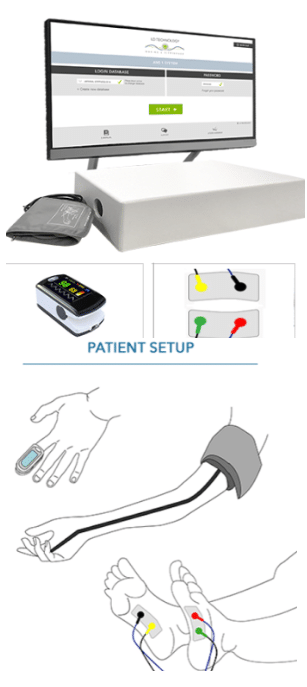ANS-1 System
The ANS-1 System utilizes the Sudomotor Testing, Autonomic Function Testing and Vascular Assessment for a complete evaluation of small fiber neuropathy, autonomic dysfunction, arterial stiffness and blood pressure.
The test is only 5 minutes and is billed with CPT Codes 95921 and 95923.
Get fast, reliable answers in-office without invasive tests. Call or complete our online form for more details.
ANS Testing
ANS-1 System Benefits
- No Human Error
- Clear Report
- Accurate Results
- 7-10 minutes (simultaneous measurements)
ANS-1 System Technologies
- Galvanic skin response
- Oscillometry
- Abd photoplethysmography
CPT Codes for ANS-1 System
- 95921 Autonomic Function Testing
- 95923 Sudomotor Testing

ANS Testing Markers
Vascular Function Assessment
Arterial stiffness
Brachial blood pressure
Endothelial Markers
Patented markers from mathematical spectral analysis of the photoplethysmography.
(Off label use)
ANS Assessment
Sudomotor markers
Heart rate variability Analysis
Cardiac Autonomic Reflex Tests (Valsalva Ratio, E/I Ratio, K30/15 Ratio and Systolic response difference while standing).
No Human Error
Accurate Results
Clear Report
Simultaneous Measurements
ANS & Artery Overview
ANS Testing Technology
SWEATC – Galvanic Skin Response
Electrical stimulation is a stressor that can affect the vascular system and has been found to increase blood flow, which is mediated in part by the release of Nitric Oxide (NO). Since electrical stimulation increases blood flow, it also increases the sweat response using a similar mechanism mediated by the release of NO
TBL-ABI – Volume Plethysmography
The ankle-brachial index (ABI) is the ratio of the systolic blood pressure (SBP) measured at the ankle to that measured at the brachial artery. It has been shown that the ABI is an indicator of atherosclerosis at other vascular sites and can serve as a prognostic marker for cardiovascular events and functional impairment, even in the absence of symptoms of PAD.
LD-OXY- Photoplethysmography.
Photoplethysmography (PTG) is an optical technique that can be used to detect blood volume changes in the microvascular bed of tissue. PTG technology has been used in a wide range of commercially available medical devices for measuring oxygen saturation, blood pressure and cardiac output, assessing autonomic function and also detecting peripheral vascular disease
